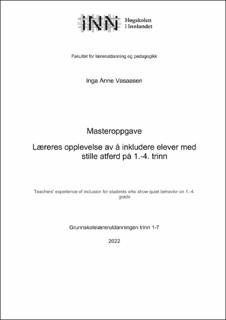Læreres opplevelse av å inkludere elever med stille atferd på 1.-4. trinn
Master thesis
Permanent lenke
https://hdl.handle.net/11250/3019771Utgivelsesdato
2022Metadata
Vis full innførselSamlinger
Sammendrag
Denne masteroppgaven handler om inkludering av elever med et stille atferdsmønster. Dette temaet har blitt undersøkt på bakgrunn av problemstillingen:
Hva er læreres opplevelse av elever som viser stille atferd, og hvordan inkluderer de denne elevgruppen?
Studien retter søkelyset mot lærerperspektivet og undersøker fire læreres opplevelse av inkludering for elever med stille atferd på tvers av tre nivåer for inkludering: fysisk, psykisk og sosial. Formålet er å fremme lærernes perspektiver gjennom drøfting av stille atferd hos elever på 1.-4. trinn og læreres handlingsmåter av inkludering på de tre nivåene. Forskerens egne forforståelse beror på at elever med stille atferd er elever som står i fare for å bli glemt i klasserommet på bakgrunn av deres lave krav til lærerens oppmerksomhet. For å kunne besvare problemstillingen har det blitt brukt en kvalitativ tilnærming. Det er brukt semi-strukturerte intervjuer og studien forankres gjennom teori om stille atferd, inkludering og elevsyn. Det er lærernes erfaringer, forståelse og opplevelser av inkludering for elever med stille atferd som ble lagt til grunn for kategoriseringen i analysen. Studiens funn viser at lærerne vektla følgende seks kategorier betydning for inkludering av elever med stille atferd: lekens betydning, rutiner, gruppestørrelse, anerkjennelse/relasjoner, forventinger og læringsmiljø. Disse seks kategoriene ble drøftet og kategorisert innenfor ett av de tre nivåene av inkludering. Her er hovedfunnet at lærerne vektla det sosiale nivået som handler om den sosiale deltakelsen, størst betydning for inkludering av elever med stille atferd. This master’s thesis is about the inclusion of students with a quiet behavior pattern. This topic has been investigated based on the following research question:
What are teachers’ experiences with students showing quiet behavior, and how do they include this group of students?
The study focuses on the teacher perspective and examines experiences of four teachers’ on inclusion of students with quiet behavior across three levels of inclusion: physical, mental and social. The purpose is to promote teachers’ perspectives through discussion of quiet behavior among students in grades 1-4 and their teachers' modes of inclusion at the three levels. The researcher’s preunderstanding is that students with quiet behavior are at risk of being forgotten in the classroom due to their low demands on the teachers’ attention. A qualitative approach has been used, and semi-structured interviews has been conducted with four teachers working on grades 1-4. The study is based on the theory of quiet behavior, inclusion, and the teacher’s view of the students. It is the teachers’ experiences and understanding of inclusion for students with quiet behavior that were used as the basis for the categorization in the analysis. The study findings show that the categories the teachers considered important for the inclusion of pupils with quiet behavior were; the importance of play, routines, group size, recognition/relationships, expectations and learning environment. These were further discussed and categorized under one of the three levels of inclusion. The main finding is that teachers in the study considered the social level about social participation, the greatest importance for the inclusion of students with quiet behavior.
